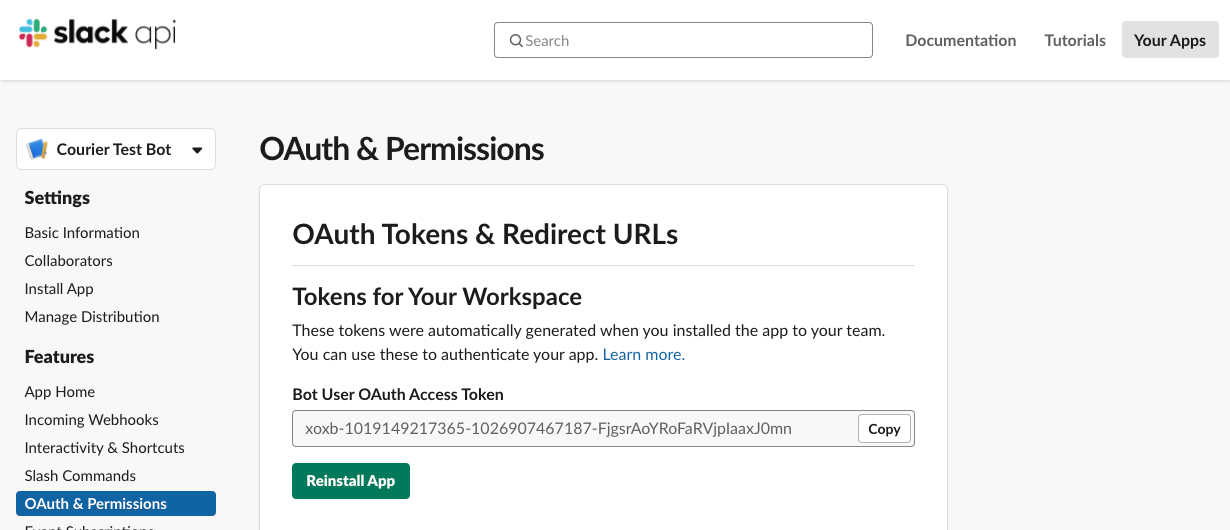
- Retrieve auth token from slack client how to#
- Retrieve auth token from slack client install#
- Retrieve auth token from slack client code#

You have exceeded the API limits that are imposed on the Qlik Web Connectors by one of the Slack V2 APIs. Slack Web API Troubleshooting You receive an error message that you have reached the API rate limit You can refer to the Slack developer documentation to learn more about the requirements and restriction imposed by the Slack V2 APIs. You receive an error message that you have reached the API rate limit Reference - Slack developer documentation If you receive this error message, then you have exceeded one of the API rate limits. While reloading your Slack-based app, you might receive an error message that the connector has reached the Slack V2 API rate limit and that all subsequent API calls will fail until the connector falls back under the throttling limit. The Qlik Web Connectors use the Slack V2 APIs to extract data from Slack and load it into your Qlik Sense app. Working with the Slack V2 API quota limits You can fetch the list of Channel IDs by running the Channels table. You can find many of these parameters when you run other tables.įor example, to run the UsersConversations table you need the Channel ID. To run some of the tables, you need to enter specific table parameters, usually in the form of an object ID or an object name. Select Insert script after you have made your selection.Ĭreating a connection and selecting data Table parameters You can select fields individually by selecting the box beside each field name. The table fields are displayed under the Data preview tab. Required parameters are marked with an asterisk (*). To select and load data from a table, enter the required table parameters and click Preview data. Lists conversations the calling user may access. Lists a conversation's history of messages and events. The table returns a list of channel IDs which are used to run other tables. This includes deleted and deactivated users.įetch the list of channels that are available to the team. With slack-sdk v3.9+, implementing the auth flow is much easier.Tables that can be loaded Tables that can be loaded. The platform feature was recently upgraded to be compatible with the standard OpenID Connect specification. Sign in with Slack helps users log into your service using their Slack profile.

Retrieve auth token from slack client code#
With Bolt, you don’t need to implement most of the above code on your own. issue () # (generated value)&client_id= # You can use WebClient with a valid token here too return make_response ( "", 200 ) # Indicate unsupported request patterns return make_response ( "", 404 )Īgain, if you’re looking for an easier solution, take a look at Bolt for Python. route ( "/slack/install", methods = ) def oauth_start (): # Generate a random value and store it on the server-side state = state_store.

environ, scopes =, user_scopes =, ) from flask import Flask, request, make_response app = Flask ( _name_ ). installation_store = FileInstallationStore ( base_dir = "./data" ) # Build with sufficient query parameters authorize_url_generator = AuthorizeUrlGenerator ( client_id = os.

state_store = FileOAuthStateStore ( expiration_seconds = 300, base_dir = "./data" ) # Persist installation data and lookup it by IDs. Import os from slack_sdk.oauth import AuthorizeUrlGenerator from slack_store import FileInstallationStore, Installation from slack_store import FileOAuthStateStore # Issue and consume state parameter value on the server-side.
Retrieve auth token from slack client how to#
The code snippet below demonstrates how to build it using Flask. Issue and consume state parameter value on the server-side. Persist installation data and lookup it by IDs. To implement this process, you can use the following modules. The first step of Slack OAuth flow is to redirect a Slack user to with a valida state parameter. Python Slack SDK provides the necessary modules for building the OAuth flow. Refer to Installing with OAuth for details. At the end of OAuth, your app gains an access token.
Retrieve auth token from slack client install#
OAuth lets a user in any Slack workspace install your app. The Python document for this module is available at App Installation Flow ¶ With Bolt, you don’t need to implement most of the following code on your own. If you’re looking for a much easier way to do the same, check Bolt for Python, which is a full-stack Slack App framework. import os from slacksdk import WebClient client WebClient(tokenos.environ'SLACKBOTTOKEN') response nversationslist() conversations response'channels' Use the types parameter to request additional channels, including publicchannel, privatechannel, mpim, and im. This section explains the details about how to handle Slack’s OAuth flow.


 0 kommentar(er)
0 kommentar(er)
